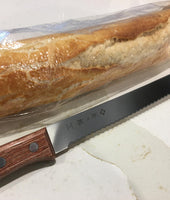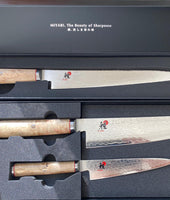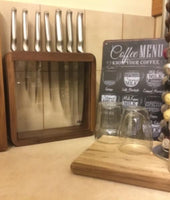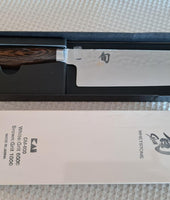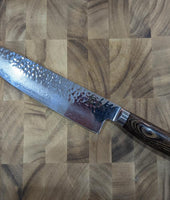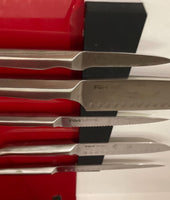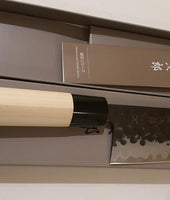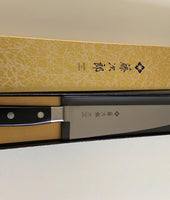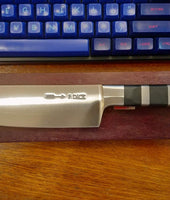5 Different Types of Kitchenware – Features & Recommendations
Cooking requires not just the right kind of skills but also the right kind of equipment. These utensils, tools, and cookware needed to prepare, serve, and cook food are called kitchenware. The range of items in kitchenware can actually be quite big. In this article, we discuss the basics.
1 - Cutting Utensils
These are important for cutting up ingredients so you can cook them in different ways. The most common cutting utensil is the kitchen knife. Take a look at some of the most commonly used knives in the kitchen.
Knives
-
The Paring Knife - This is a small knife that comes in handy when you need to peel fruits and vegetables, make delicate patterns on them or core fruits like apples. Its size allows you to hold it aloft instead of chopping on the chopping board.
-
The Bread Knife - A bread knife is typically long and serrated. This allows it to cut through the hard crust of the bread without squishing it and producing many crumbs. It can also be used to cut cakes and even hard fruits and vegetables.
ZWILLING J.A. Henckels Pro Bread Knife 20cm
-
The Serrated Knife - The serrated knife is longer than the bread knife. It is mostly used to cut large pieces of cooked meat such as roast turkey, chicken, and beef.
-
The Boning Knife- When you need to separate meat from the bone and leave it clean, this is the knife for you. It has a long, thin, and sometimes flexible blade, like this F DICK ActiveCut Boning Knife Flexible 15cm. This helps it to cut in between meat and bone to separate the two without losing any of the meat juices.
-
The Chef's Knife - This is the most frequently used knife in the kitchen. It is broad and bulky and can do just about anything from chopping up and slicing veggies to cutting up meat.
While knives are indispensable in the kitchen, they're not the only important cutting utensils. Here are other utensils which also help to complement the function of knives.
2 - Knife Sharpener
Knives should never be allowed to go dull. Every kitchen should have a knife sharpener to maintain the knives in good condition. Here are the most common types of knife sharpeners.
-
Whetstone - This is a natural or artificial stone with a gritty surface used to sharpen knives by grinding Whetstones require some level of skill so as not to damage the knife edge.
-
Pull-through Sharpener - A manual sharpener is easier to use than a whetstone. It consists of two main slots- coarse grit and smooth grit- through which you draw the knife repeatedly to sharpen it. It also comes with a handle to allow you to hold it firmly when sharpening.
-
The Electric Sharpener - This is similar to a pull-through sharpener, as it also comes with coarse grit and a smooth grit slot. It has motorized wheels that spin when the sharpener is turned on. Some electric sharpeners come with a guide that allows you to sharpen a blade to a specified angle, like the KitchenIQ™ Ceramic Edge Knife Sharpener & Honer - Electric. This makes them easier to use than whetstones or pull-through sharpeners.

-
The honing rod- Technically speaking, this isn't really a sharpener. It is used to straighten the edge of an already sharp knife.
3 - The Cutting Board
A cutting board provides a firm surface on which you can cut ingredients. Most cutting boards are made of hardwood like the Tojiro Pro Kiri Wood Japanese Cutting Board Medium, or plastic material like the Carl Schmidt HOLSTEIN plastic cutting board with marble look 30x20x0.6cm.
These are hard enough not to get too badly scratched, but not so hard that they damage the edge of the knife. Never cut stuff on a marble countertop or a ceramic plate as these surfaces are too hard on the knife edge.
4 - Non-Sharp Utensils
Kitchenware also includes some non-sharp utensils. These are still used to break down ingredients into smaller pieces. Here are some of them:
-
The Nutcracker - If you use nuts a lot, you need a nutcracker in your kitchen. It will break open any nut with ease. The Carl Schmidt HEMAU Zinc Alloy Nut Cracker can crack up seafood as well.
-
Kitchen Mallet - A kitchen mallet has a pointed side and a flat The pointed side is used for tenderizing meat to make the marinades penetrate easily and to soften the meat. The flat side is used to hammer hard food to soften it or break it apart.
-
A Garlic Press - If you don't enjoy having to slice garlic into tiny pieces, get yourself a garlic press. With this utensil, you just need to put the clove of garlic into the press and squeeze it into your food.

Carl Schmidt EXQUISITE Stainless Steel Kitchen Utensils Garlic Press 21 cm
-
Pestle and Mortar - When you need to grind herbs or roots into a fine powder, a pestle and mortar will come in handy.
-
A Whisk - While electric mixers are easier to use and mix ingredients faster, a whisk is handy when you just need to mix something simple like eggs
-
A Peeler - Having a lot of ingredients to peel can get quite exhausting. A peeler makes it easier and is safer than a knife.
5 - Cookware
Cookware is an important type of kitchenware. They are simply vessels used for cooking. Cookware is quite diverse, but there are some that you will never miss in any kitchen.
-
Stockpots - A stockpot is a large, deep pan with straight sides and a flat It's used to cook pasta as it is big enough to accommodate it. It can also be used for food that doesn't have to be near the source of heat such as meat broth.
-
A Saucepan - A saucepan is straight-sided, round and deep, but not as deep as a stockpot. It also has a handle or two, and a lid. Saucepans are very versatile. They can be used for boiling food, reheating leftovers, making soups and sauces, and preparing grains.

Carl Schmidt Marburg Non-Stick Saucepan Pot Casserole wLid 24cm
-
A Sauté Pan- This pan is also straight-sided, but shallower than a saucepan. It has a flat base and comes with a lid. It can be used to prepare sauces and deep fry
-
A Frying Pan - This pan has rounded sides and is shallower than the sauté; pan. It is used for stir-frying and doesn't come with a lid.
Final Words
So now that you have a basic idea of kitchenware, and what you need to build up your kitchen, you can go out and get doing some kitchenware shopping by clicking here!































